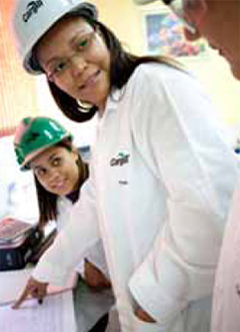Humane Practices

HEALTH AND SAFETY
According to one of its global guidelines, in May 2009, a year in advance of the stipulated deadline, Cargill completed the introduction of its Safe Behavior Process in all its local units. The Process is based on identification, through on-site observation of everyday tasks, possible unsafe attitudes and barriers that impede the adoption of the proper problem-solving measures. Staff are trained to perform this function and provide feedback to those carrying out the activities, addressing body position, observance of operational procedures, use of tools, equipment, cleaning and storage, and use of Personal Protection Equipment (PPE). Every month, each unit issues a report with the results achieved, and every quarter these figures are reported to the company’s headquarters in Minneapolis.
Although the results of this process tend to reveal themselves later on, since it involves an aspect of cultural change, the estimate is that the Reportable Injury Frequency Rate (RIFR), which indicates the number of medical cases, will be reduced. The index reached 0.9 in 2009, which is well below the corporate global target that allows 3.0. In the previous year, when Seara’s data was still included, the RIFR was 2.5.
Cargill did not report any deaths of a professional in service and continued its awareness actions on the theme through workshops and Work Accident Prevention Weeks (SIPATs), for example. The employees who use company vehicles are instructed so as to reduce the risk of traffic accidents, one of the most recurrent types. The idea is to encourage total concentration when driving.
The company also takes the safety of its service providers seriously. When hiring contractors, Cargill requires them to comply with a series of safety standards and, at conclusion of service, evaluates their performance. New suppliers are admitted on the basis of criteria that include safety. Furthermore, all construction foremen undergo two days of worker-safety training. There are also committees at most plants and ports to ensure that these actions are carried out. At some units, the work is carried out by the Internal Accident Prevention Committees (CIPAS).
Other measures aimed at health and welfare of employees are the physical activity and exercise programs in some locations.
| Health and safety indicators | |
|---|---|
| Man-hours worked* | 12.478.718 hh |
| Accidents without lost time | 46 |
| Lost-time accidents | 12 |
| Total accidents | 58 |
| Absenteeism index | 0,51 |
| Overtime/year | 66.122 |
| Days lost | 290 |
| Days discounted | 4.234 |
| Reportable Injury Frequency Rate | 0.9 |
| Severity Rate | 4.6 |

*Includes man-hours of outsourced workers under direct supervision of Cargill




